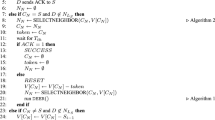Abstract
Currently, the mobile ad hoc networks are experiencing quicker progression since due to their minimal cost, variance and unfussiness of the autonomous devices. These devices could arrange into a dependable network in a short duration for the utilization of salvage systems after natural calamities where the transmission structure might no longer last. These nodes in this kind of networks are possible to wander freely at any point of time even in the non-existence of any planner supervision where routing is deemed as a great dispute. Furthermore, various routing standards like Neighbor Coverage-Based Probabilistic Rebroadcast (NCPR) purely depend on the predetermined values which are needed to be assigned by the system supervisor for the conditions. Unluckily the initialization of a precise condition is not appropriate for other conditions. Additionally, various other protocols like Adhoc on-demand distance vector routing (AODV) uses the route demand message flooding mechanism to locate a route to a precise target in the path identification process. Even though the flooding assures improved reach but it initiates unwanted overheads during routing this might degrade the performance of the network. The intention is to design a fresh routing standard adjacency based energetic association factor routing protocol (EAPF) suitable to vigorously investigate the position of the fundamental network without disturbing the system supervisor based on a fresh association parameter while minimizing the overheads in route demands employing a fresh association factor. Moreover, the broad simulation reveals the performance of EAPF, NCPR and AODV where the designed schemes resolve the necessity for predetermined values in NCPR. It is evident that the proposed scheme performs better than the NCPR and AODV in terms of end-to-end delay, overheads in routing, rate of MAC collisions, energy utilization, network associations and packet delivery ratio because of its fresh schemes for minimizing the unnecessary route demands.







Similar content being viewed by others
Reference
Ayyash, M., Alsbou, Y., & Anan, M. (2015). Introduction to mobile ad-hoc and vehicular networks in wireless sensor and mobile Ad-Hoc networks. . New York: Springer.
Safa, H., Karam, M., & Moussa, B. (2014). Phaodv: Power aware heterogeneous routing protocol for WSNs. Journal of Network and Computer Applications, 46, 60–71.
SY Ni, YC Tseng, YS Chen, and JP Sheu 1999 The broadcast storm problem in a mobile ad hoc network. In: Proceedings Mobile Comput 151–162
Tseng, Y. C., Ni, S. Y., Chen, Y. S., & Sheu, J. P. (2002). The broadcast storm problem in a mobile ad hoc network. Wireless Networks, 8(2), 153–167.
C Perkins et al, 2003 Rfc 3561-ad hoc on-demand distance vector (aodv) routing. In: Proceeding Internet RFCs, 1–38
D Johnson, Y Hu, and D Maltz 2007 Rfc: 4728,'' The Dynamic Source Routing Protocol (DSR) for Mobile Ad Hoc Networks for IPV4, document
YB Ko and NH Vaidya, 2000 Location-aided routing (lar) in mobile ad hoc networks, Wireless Netw 6, 4, 307–321
ZJ Haas, MR Pearlman, and P Samar 2002 The Zone Routing Protocol (ZRP) for Ad Hoc Networks, document draft-ietf-WSN-zone-zrp-04.txt
B Williams and T Camp 2002 Comparison of broadcasting techniques for mobile ad hoc networks. In Proceedings 3rd ACM Int. Symp. Mobile Ad Hoc Netw. Comput., 194–205
J.-S. Kim, Q. Zhang, and D. P. Agrawal 2004Probabilistic broadcasting based on coverage area and neighbor confirmation in mobile ad hoc networks. In: Proceedings IEEE Global Telecommun. Conference Workshops GlobeCom Workshops, 96–101
Al Amri, H., Abolhasan, M., & Wysocki, T. (2010). Scalability of WSN routing protocols for heterogeneous and homogenous networks. Computers & Electrical Engineering, 36(4), 752–765.
Reina, D. G., Toral, S. L., Johnson, P., & Barrero, F. (2015). A survey on probabilistic broadcast schemes for wireless ad hoc networks. Ad Hoc Networks, 25, 263–292.
A Mohammed, M Ould-Khaoua, and L Mackenzie, 2007 An efficient counter-based broadcast scheme for mobile ad hoc networks. For- mal Methods and Stochastic Models for Performance Evaluation, 275–283.
Yassein, M. B., Nimer, S. F., & Al-Dubai, A. Y. (2011). A new dynamic counterbased broadcasting scheme for mobile ad hoc networks. Simulation Modelling Practice and Theory, 19(1), 553–563.
Bakhouya, M., Gaber, J., & Lorenz, P. (2011). An adaptive approach for information dissemination in vehicular ad hoc networks. Journal of Network and Computer Applications, 34(6), 1971–1978.
Chandru, V. C., & Karthik, S. (2020). Predicting the position of adjacent nodes with QoS in mobile ad hoc networks. Multimed Tools Appl, 79, 8445–8457. https://doi.org/10.1007/s11042-018-5842-7.
Gautham Rajmohan, G., Vignesh, C., Daniel, A., Chandrakrishan Balakrishnan, S., Muthu, B. A., & Manogaran, G. (2020). Revamping land coverage analysis using aerial satellite image mapping. Trans. Emerging Tel. Tech. https://doi.org/10.1002/ett.3927.
Punitha, P., Santhosh Kumar, B., & Karthik, S. (2015). A survey for reducing delay and interference constrain using Hop-By-Hop cross-layer congestion control scheme in MANET. Int. J. Appl. Eng. Res. (IJAER), 10(85), 140–148.
K Rajakumari, P Punitha, R Lakshmanakumar and C Suresh 2020 Improvising packet delivery and reducing delay ratio in mobile adhoc network using neighbour coverage based topology control algorithm. International Journal of Communication System
Lakshmanakumar, R., Bhavdharini, R. M., & Karthik, S. (2015). A Secure Routing protocol for detecting packet dropping attacks in MANET. Int. J. Appl. Eng. Res. (IJAER), 10(85), 140–148.
Author information
Authors and Affiliations
Corresponding author
Additional information
Publisher's Note
Springer Nature remains neutral with regard to jurisdictional claims in published maps and institutional affiliations.
Rights and permissions
About this article
Cite this article
Vignesh, C.C., Sivaparthipan, C.B., Daniel, J.A. et al. Adjacent Node based Energetic Association Factor Routing Protocol in Wireless Sensor Networks. Wireless Pers Commun 119, 3255–3270 (2021). https://doi.org/10.1007/s11277-021-08397-0
Accepted:
Published:
Issue Date:
DOI: https://doi.org/10.1007/s11277-021-08397-0




